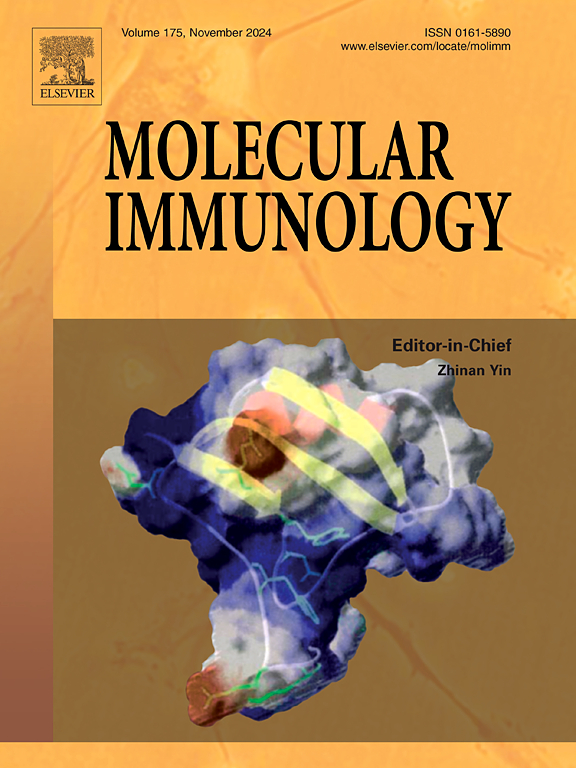WISP1 promotes the progression of rheumatoid arthritis through NLRP3 inflammasome activation
IF 3.2
3区 医学
Q2 BIOCHEMISTRY & MOLECULAR BIOLOGY
引用次数: 0
Abstract
Background
Rheumatoid arthritis (RA) is a chronic autoimmune disease without effective treatments. This study explored WNT1 inducible signaling pathway protein 1 (WISP1) as a potential target to prevent RA.
Methods
AAV-shRNA-WISP1 or AAV-NC was injected in each ankle of collagen-induced arthritis (CIA) rats. Si-WISP1 or NC vector was transfected to TNF-α-induced fibroblast-like synoviocytes (FLSs). The effects of WISP1 knockdown on levels of pro-inflammatory factors in rats or FLSs were examined by qRT-PCR, ELISA, and western blot. CCK-8, Wound-healing, and transwell assays were used to estimate the effects of WISP1 knockdown on TNF-α-induced cell vitality, migration, and invasion in FLSs. The NLRP3 inflammasome-related proteins were checked by immunohistochemistry, immunofluorescence assay, and western blot in rats or FLSs.
Findings
Administration of WISP1 knockdown improved joint damage and diminished synovial inflammation in CIA rats. WISP1 knockdown restrained TNF-α-induced cell vitality, migration, and invasion in FLSs. In CIA rats and TNFα-induced FLSs, WISP1 knockdown reduced the secretion of inflammatory factors and restrained NLRP3 inflammasome activation.
Interpretation
WISP1 knockdown effectively inhibited NLRP3 inflammasome activation and inflammatory factors levels.
WISP1通过NLRP3炎性体激活促进类风湿关节炎的进展
背景类风湿性关节炎(RA)是一种慢性自身免疫性疾病,目前尚无有效的治疗方法。本研究探索WNT1诱导的信号通路蛋白1 (WISP1)作为预防RA的潜在靶点。方法将saav - shrna - wisp1或AAV-NC分别注射于胶原性关节炎(CIA)大鼠各踝关节。Si-WISP1或NC载体转染TNF-α-诱导的成纤维细胞样滑膜细胞(FLSs)。采用qRT-PCR、ELISA和western blot检测WISP1基因敲低对大鼠或FLSs促炎因子水平的影响。CCK-8、伤口愈合和transwell实验用于评估WISP1敲低对TNF-α-诱导的FLSs细胞活力、迁移和侵袭的影响。采用免疫组化、免疫荧光法和western blot检测大鼠或FLSs NLRP3炎性小体相关蛋白的表达。结果:WISP1基因敲低可改善CIA大鼠关节损伤,减轻滑膜炎症。WISP1敲低抑制TNF-α-诱导的FLSs细胞活力、迁移和侵袭。在CIA大鼠和tnf α诱导的FLSs中,WISP1敲低可减少炎症因子的分泌,抑制NLRP3炎性体的激活。wisp1基因敲低可有效抑制NLRP3炎性体激活和炎性因子水平。
本文章由计算机程序翻译,如有差异,请以英文原文为准。
求助全文
约1分钟内获得全文
求助全文
来源期刊

Molecular immunology
医学-免疫学
CiteScore
6.90
自引率
2.80%
发文量
324
审稿时长
50 days
期刊介绍:
Molecular Immunology publishes original articles, reviews and commentaries on all areas of immunology, with a particular focus on description of cellular, biochemical or genetic mechanisms underlying immunological phenomena. Studies on all model organisms, from invertebrates to humans, are suitable. Examples include, but are not restricted to:
Infection, autoimmunity, transplantation, immunodeficiencies, inflammation and tumor immunology
Mechanisms of induction, regulation and termination of innate and adaptive immunity
Intercellular communication, cooperation and regulation
Intracellular mechanisms of immunity (endocytosis, protein trafficking, pathogen recognition, antigen presentation, etc)
Mechanisms of action of the cells and molecules of the immune system
Structural analysis
Development of the immune system
Comparative immunology and evolution of the immune system
"Omics" studies and bioinformatics
Vaccines, biotechnology and therapeutic manipulation of the immune system (therapeutic antibodies, cytokines, cellular therapies, etc)
Technical developments.
 求助内容:
求助内容: 应助结果提醒方式:
应助结果提醒方式:


